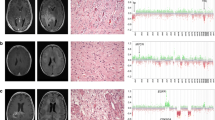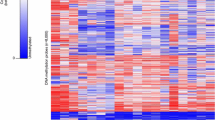Abstract
The current WHO classification of brain tumors defines gliomatosis cerebri (GC) as an extensively infiltrating astrocytic glioma involving at least three cerebral lobes. The relation of GC to diffuse astrocytomas and glioblastoma is uncertain. Due to malignant biological behavior, GC is allotted to WHO grade III. Recent reports showed IDH1 mutations in astrocytic and oligodendroglial tumors WHO grades II and III and in secondary glioblastomas with a frequency of up to 90%, whereas IDH1 mutations occurred in only 5% of primary glioblastomas. Here, we examined the frequency of IDH1 mutations in 35 GC samples by direct sequencing, derived cleaved amplified polymorphic sequence analysis and immunohistochemistry. We identified IDH1 mutations in 10/24 (42%) cases, which also included a solid tumor portion (type 2 GC), but not in 11 “classical” cases without solid tumor mass (type 1 GC). TP53 mutations were revealed in two type 2 GC, but not in any type 1 GC, while combined chromosomal losses of 1p and 19q were not found at all. Our data suggest that GC consists of two histological/molecular subtypes, type 1 being clearly distinct from diffuse astrocytoma, and type 2 sharing features with diffuse astrocytoma.

Similar content being viewed by others
References
Balss J, Meyer J, Mueller W et al (2008) Analysis of the IDH1 codon 132 mutation in brain tumors. Acta Neuropathol 116:597–602
Bleeker FE, Atai NA, Lamba S et al (2010) The prognostic IDH1(R132) mutation is associated with reduced NADP+-dependent IDH activity in glioblastoma. Acta Neuropathol 119:487–494
Capper D, Weissert S, Balss J et al (2010) Characterization of R132H mutation-specific IDH1 antibody binding in brain tumors. Brain Pathol 20:245–254
Capper D, Zentgraf H, Balss J et al (2009) Monoclonal antibody specific for IDH1 R132H mutation. Acta Neuropathol 118:599–601
Dang L, White DW, Gross S et al (2009) Cancer-associated IDH1 mutations produce 2-hydroxyglutarate. Nature 462:739–744
Dubbink HJ, Taal W, van Marion R et al (2009) IDH1 mutations in low-grade astrocytomas predict survival but not response to temozolomide. Neurology 73:1792–1795
Hartmann C, Meyer J, Balss J et al (2009) Type and frequency of IDH1 and IDH2 mutations are related to astrocytic and oligodendroglial differentiation and age: a study of 1010 diffuse gliomas. Acta Neuropathol 118:469–474
Herrlinger U, Felsberg J, Kuker W et al (2002) Gliomatosis cerebri: molecular pathology and clinical course. Ann Neurol 52:390–399
Ichimura K, Pearson DM, Kocialkowski S et al (2009) IDH1 mutations are present in the majority of common adult gliomas but rare in primary glioblastomas. Neuro Oncol 11:341–347
Jennings MT, Frenchman M, Shehab T et al (1995) Gliomatosis cerebri presenting as intractable epilepsy during early childhood. J Child Neurol 10:37–45
Kannuki S, Hondo H, Ii K et al (1997) Gliomatosis cerebri with good prognosis. Brain Tumor Pathol 14:53–57
Kleihues P, Burger PC, Scheithauer BW et al (1993) Histological typing of tumours of the central nervous system, 2nd edn. Springer, Berlin
Kleihues P, Cavenee WK (2000) Pathology and genetics of tumours of the nervous system, 2nd edn. IARC Press, Lyon
Kros JM, Zheng P, Dinjens WN et al (2002) Genetic aberrations in gliomatosis cerebri support monoclonal tumorigenesis. J Neuropathol Exp Neurol 61:806–814
Louis DN, International Agency for Research on Cancer (2007) WHO classification of tumours of the central nervous system. World Health Organization classification of tumours, 4th edn. International Agency for Research on Cancer, Lyon
Mawrin C (2005) Molecular genetic alterations in gliomatosis cerebri: what can we learn about the origin and course of the disease? Acta Neuropathol 110:527–536
Mawrin C, Aumann V, Kirches E et al (2001) Gliomatosis cerebri: post-mortem molecular and immunohistochemical analyses in a case treated with thalidomide. J Neurooncol 55:11–17
Mawrin C, Kirches E, Schneider-Stock R et al (2003) Analysis of TP53 and PTEN in gliomatosis cerebri. Acta Neuropathol 105:529–536
Mawrin C, Lins H, Kirches E et al (2003) Distribution of p53 alterations in a case of gliomatosis cerebri. Hum Pathol 34:102–106
Meyer J, Pusch S, Balss J et al (2010) PCR- and restriction endonuclease-based detection of IDH1 mutations. Brain Pathol 20:298–300
Nevin S (1938) Gliomatosis cerebri. Brain 61:170–191
Park S, Suh YL, Nam DH et al (2009) Gliomatosis cerebri: clinicopathologic study of 33 cases and comparison of mass forming and diffuse types. Clin Neuropathol 28:73–82
Parsons DW, Jones S, Zhang X et al (2008) An integrated genomic analysis of human glioblastoma multiforme. Science 321:1807–1812
Sanson M, Marie Y, Paris S et al (2009) Isocitrate dehydrogenase 1 codon 132 mutation is an important prognostic biomarker in gliomas. J Clin Oncol 27:4150–4154
Taillibert S, Chodkiewicz C, Laigle-Donadey F et al (2006) Gliomatosis cerebri: a review of 296 cases from the ANOCEF database and the literature. J Neurooncol 76:201–205
Ware ML, Hirose Y, Scheithauer BW et al (2007) Genetic aberrations in gliomatosis cerebri. Neurosurgery 60:150–158 (discussion 158)
Watanabe T, Nobusawa S, Kleihues P et al (2009) IDH1 mutations are early events in the development of astrocytomas and oligodendrogliomas. Am J Pathol 174:653–656
Weller M, Felsberg J, Hartmann C et al (2009) Molecular predictors of progression-free and overall survival in patients with newly diagnosed glioblastoma: a prospective translational study of the german glioma network. J Clin Oncol 27:5743–5750
Wick W, Hartmann C, Engel C et al (2009) NOA-04 randomized phase III trial of sequential radiochemotherapy of anaplastic glioma with procarbazine, lomustine, and vincristine or temozolomide. J Clin Oncol 27:5874–5880
Yan H, Parsons DW, Jin G et al (2009) IDH1 and IDH2 mutations in gliomas. N Engl J Med 360:765–773
Zhao S, Lin Y, Xu W et al (2009) Glioma-derived mutations in IDH1 dominantly inhibit IDH1 catalytic activity and induce HIF-1alpha. Science 324:261–265
Zülch KJ, World Health Organization (1979) Histological typing of tumours of the central nervous system. World Health Organization, Geneva
Acknowledgments
We thank F. Mößler and K. Lindenberg for skilfull technical assistance. This work was supported by grants from Bundesministerium für Bildung und Forschung (BMBF) to AvD and CH (grant numbers 01GS0883 and 01ES0729-30).
Author information
Authors and Affiliations
Corresponding author
Additional information
M. Seiz and J. Tuettenberg contributed equally to this study.
Rights and permissions
About this article
Cite this article
Seiz, M., Tuettenberg, J., Meyer, J. et al. Detection of IDH1 mutations in gliomatosis cerebri, but only in tumors with additional solid component: evidence for molecular subtypes. Acta Neuropathol 120, 261–267 (2010). https://doi.org/10.1007/s00401-010-0701-2
Received:
Revised:
Accepted:
Published:
Issue Date:
DOI: https://doi.org/10.1007/s00401-010-0701-2




